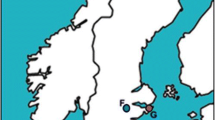Abstract
In a preliminary survey of genetic variability among 12 Australian isolates of Puccinia coronata f. sp. avenae Fraser and Led (Pca) collected from 1966 to 1993, two relatively diverse (< 76% similarity) clusters were found with selectively neutral DNA markers. Five US isolates included for comparison formed a third cluster, intermediate to the two clusters of Australian isolates. The two Australian sub-populations may have resulted from exotic introductions of genetically distinct isolates of Pca. Given that Pca does not undergo sexual recombination in Australia, these isolates may have acted as founding isolates from which new genotypes arose via mutation. Within the Australian isolates, three pairs of isolates that possessed identical DNA Amplification Fingerprints (DAF) or phenotypes were also identical or similar in virulence phenotype. The differences in pathogenicity observed within two of these pairs could have resulted from mutations to virulence for resistance genes present in Australian oat cultivars. A low overall correlation was found between pathogenic variability and variability in DAF banding pattern. This may be a reflection of host-directed selection of virulences independent of an isolate’s background genotype or an indication that mechanisms other than clonal propagation and random mutation contribute to genetic variability in Pca in Australia. The results obtained indicated that DNA-based marker systems are useful in revealing information about the genetic backgrounds of Australian Pca isolates, and provide an experimental basis for further detailed studies.
Similar content being viewed by others
References
Bartos P, Fleischmann G, Samborski DJ, Shipton WA (1969) Studies on asexual variation in the virulence of oat crown rust, Puccinia coronata f. sp. avenae, and wheat leaf rust, Puccinia recondita. Canadian Journal of Botany 47, 1383–1387.
Bassam BJ, Caetano-Anolles G, Gresshoff PM (1991) Fast and sensitive silver staining of DNA in polyacrylamide gels. Annals of Biochemistry 80, 81–84.
Bonnett DG (1996) Host: pathogen studies of oat leaf rust in Australia. PhD Thesis, University of Sydney, Australia.
Brake VM, Irwin JAG (1992) Partial resistance of oats to P. coronata f.sp. avenae. Australian Journal of Agricultural Research 43, 1217–1227.
Brouwer JB, Oates JD (1986) Regional variation of Puccinia coronata avenae in Australia and its implications for oat breeding. Annals of Applied Biology 109, 269–277.
Burdon JJ, Oates JD, Marshall DR (1983) Interactions between Avena and Puccinia species. I. The wild hosts: Avena barbata Pott ex Link., A. fatua L., A. ludoviciana Durieu. Journal of Applied Ecology 20, 571–584.
Chen XM, Line RF, Leung H (1993) Relationship between virulence variation and DNA polymorphism in Puccinia striiformis in North America. Phytopathology 83, 1489–1497.
Harder DE, Haber S (1992) Oat diseases and pathologic techniques. In ‘Oat science and technology’. (Eds HG Marshall and ME Sorrells) pp. 307–425. (American Society of Agronomy Inc.: Wisconsin, USA)
Luig NH (1985) Epidemiology in Australia and New Zealand. In ‘The cereal rusts, Vol. II. Diseases, distribution, epidemiology, and control’. (Eds AP Roelfs and WR Bushnell) pp. 301–328. (Academic Press Inc.: Orlando, USA)
Nicholson P, Rezanoor HN (1994) The use of random amplified polymorphic DNA to identify pathotype and detect variation in Pseudocercosporella herpotrichoides. Mycological Research 98, 13–21.
Park RF, Burdon JJ, Jahoor A (1999) Evidence for somatic hybridization in nature in Puccinia recondita f. sp. tritici, the leaf rust pathogen of wheat. Mycological Research 103, 715–723.
Park RF, Burdon JJ, McIntosh RA (1995) Studies on the origin, spread, and evolution of an important group of Puccinia recondita f. sp. tritici pathotypes in Australasia. European Journal of Plant Pathology 101, 613–622.
Park RF, Jahoor A, Felsentstein FG (2000a) Population structure of Puccinia recondita in Western Europe during 1995, as assessed by variability in pathogenicity and molecular markers. Journal of Phytopathology 148, 169–179.
Park RF, Meldrum SM, Oates JD (2000b) Recent pathogenic changes in the leaf (brown) rust pathogen of wheat and the crown rust pathogen of oats in Australia in relation to host resistance. Acta Phytopathologica et Entomologica Hungarica 35, 387–394.
Rogers O, Rehner S, Bledsoe C, Mueller G, Ammirati J (1989) Extraction of DNA from Basidiomycetes for ribosmal DNA hybridization. Canadian Journal of Botany 67, 1235–1243.
Rohlf FJ (1997) ‘NTSYS-pc: numerical taxonomy and multivariate analysis system.’ Version 2.00. (Exeter software: Setauket, NY, USA)
Simons MD (1970) ‘Crown rust of oats and grasses.’ Monograph No. 5. (The American Phytopathological Society, APS Press: St Paul, MN)
Simons MD, Murphy HC (1955) A comparison of certain combinations of oat varieties as crown rust differentials. US Department of Agriculture, Technical Bulletin No. 1112. pp. 1-22.
Waterhouse WH (1952) Australian rust studies. IX. Physiologic race determinations and surveys of cereal rusts. Proceedings of the Linnean Society of New South Wales 77, 209–258.
Watson IA (1981) Wheat and its rust parasites in Australia. In ‘Wheat science — today and tomorrow’. (Eds LT Evans and WJ Peacock) pp. 129–147. (Cambridge University Press: Cambridge)
Wellings CR, McIntosh RA (1990) Puccinia striiformis f. sp. tritici in Australasia: pathogenic changes during the first 10 years. Plant Pathology 39, 316–325.
Welsh J, McClelland M (1990) Fingerprinting genomes using PCR with arbitrary primers. Nucleic Acids Research 18, 7213–7218.
Williams JGK, Kubelik AR, Livak KJ, Rafalski JA, Tingey SV (1990) DNA polymorphisms amplified by arbitrary primers are useful as genetic markers. Nucleic Acids Research 18, 6531–6535.
Yap I, Nelson RJ (1996) ‘WinBoot: a program for performing bootstrap analysis of binary data to determine confidence limits of UPGMAbased dendrograms.’ IRRI Discussion Paper Series No. 14. (International Rice Research Institute, PO Box 933, Manila, Philippines)
Author information
Authors and Affiliations
Corresponding author
Rights and permissions
About this article
Cite this article
Brake, V.M., Irwin, J.A.G. & Park, R.F. Genetic variability in Australian isolates of Puccinia coronata f. sp. avenae assessed with molecular and pathogenicity markers. Australasian Plant Pathology 30, 259–266 (2001). https://doi.org/10.1071/AP01039
Received:
Accepted:
Issue Date:
DOI: https://doi.org/10.1071/AP01039




